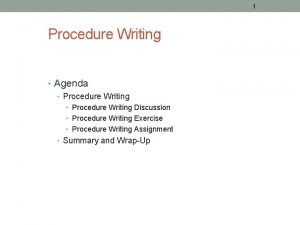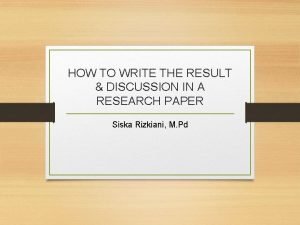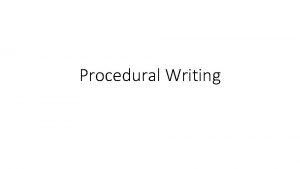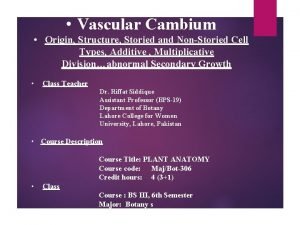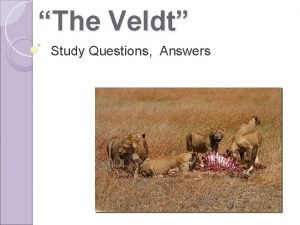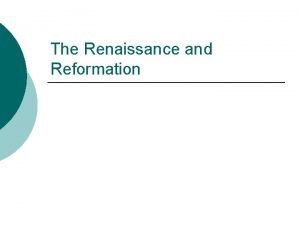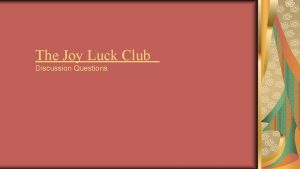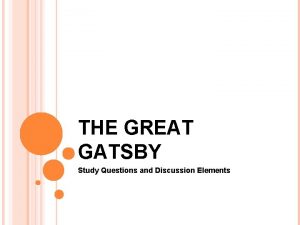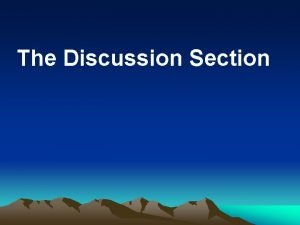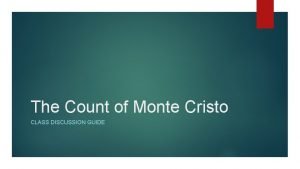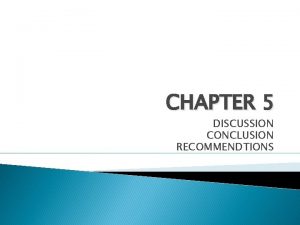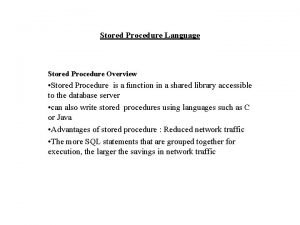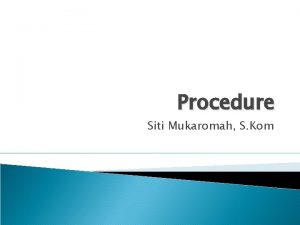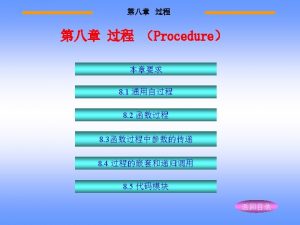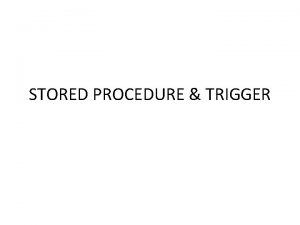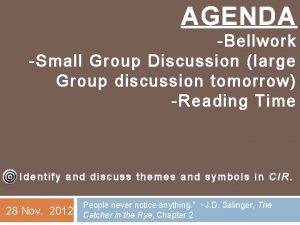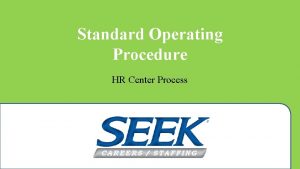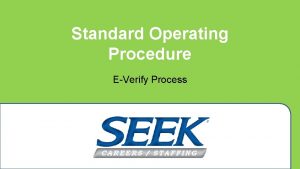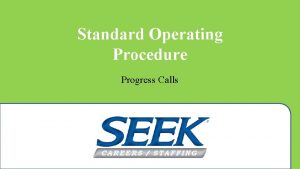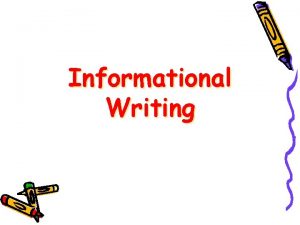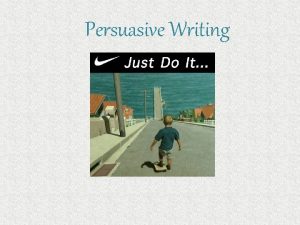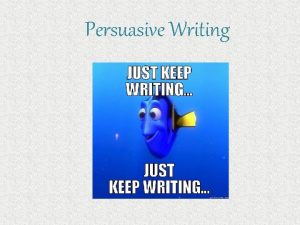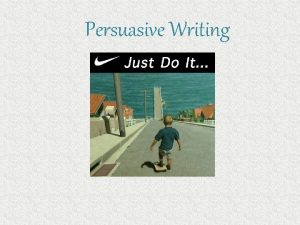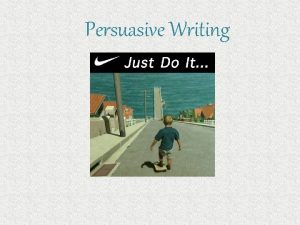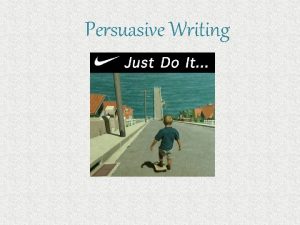1 Procedure Writing Agenda Procedure Writing Discussion Procedure





















- Slides: 21

1 Procedure Writing • Agenda • Procedure Writing Discussion • Procedure Writing Exercise • Procedure Writing Assignment • Summary and Wrap-Up

2 Performance Objective • Student will write and be able to interpret operations procedures that insure compliance with safety, environmental and government regulations.

3 Student Learning Outcomes • Recognize various procedure types and when to use them • Recognize various procedure formats and when to use them • Describe typical content items found within procedures • Use good technical writing techniques • Write procedural steps and supporting information

4 Overview • Purpose of Procedures: • To train • To operate • To inform • Users of Procedures: • Employees in most modern companies • General public

5 Procedure Types • Administrative • Hiring • Human Resources • Emergency • Response to fire • Response to spill • Operations • Production • Laboratory • SH&E • Climbing a ladder • Recycling chemicals

6 Procedure Format • Traditional • Steps sequenced in a linear, top down format • Written for tasks that involve one performer (actor)

7 Procedure Format • Playscript • Steps sequenced in a columnar format • Written for tasks that involve MORE THAN one performer (actor) OR department

8 Procedure Format • T- Style • Steps sequenced in a columnar format • Written for tasks where screen displays need to be acknowledged OR knowledge of “hidden actions” is critical

9 Procedure Content • Title • Document Control Information • Purpose • Scope • References

10 Procedure Content (continued) • Key Responsibilities • Step-By-Step Instructions • Safety Health & Environment Information • Prior to the instructions • Embedded in the instructions • Technical Information • Prior to the instructions • Embedded in the instructions

11 Technical Writing Techniques • Be concise • List steps in proper sequential order • Use short sentences • Divide long procedures into sections with sub-titles • Use equipment names and identifiers (numbers)

12 Technical Writing Techniques Action verb • Use action statements Action limit • Action verb • Object of the action Object Identifier • Action limits 1. Slowly open • Object identifiers bleed valve on • Object locators Vacuum Pump # 23. Object of Action Object Locator

13 Technical Writing Techniques • Use notes, cautions and warnings appropriately • Placed BEFORE the step to which they apply • Differentiate with font color or style • Notes: Need to know information • Cautions: Hazard CAN be encountered • Warnings: Hazard WILL be encountered

14 Technical Writing Techniques • Use “If-Then” statements for clarity • Situations which require a condition to be satisfied • “IF” clause provides EXPECTED condition • “THEN” clause provides NECESSARY ACTION

15 Technical Writing Techniques • Use “branching” when necessary • Situations when user must refer to another location in the same procedure • Situations when user must refer to another procedure • Keep “branching” to a minimum

16 Technical Writing Techniques • Consider the” tone of voice” used in the document • Avoid giving orders • Avoid the word “should” • Avoid humor

17 Technical Writing Techniques • Consider the reader/user • Make the document visually appealing • Keep vocabulary simple and consistent • Treat readers/users as adults • Do not use people’s names; use titles

18 Technical Writing Techniques • Grammar Pointers • Write in the second person • Use the active voice (the “understood you”)

19 Procedure Writing Exercise • Write a procedure in small groups • Use technical writing tips covered earlier • Task: “Making a pot of coffee”

20 Procedure Writing Assignment • Split into teams • Use technical writing tips covered earlier • Write a procedure for running and testing a prototype battery.

21 Summary & Wrap-Up • Procedure Types • Procedure Formats • Procedure Content • Technical Writing Techniques • Homework • Write an operating procedure for running and testing a prototype battery.
 Discussion of simple distillation
Discussion of simple distillation Agenda sistemica y agenda institucional
Agenda sistemica y agenda institucional Discussion procedure
Discussion procedure Dialogue examples for students
Dialogue examples for students Discussion of result
Discussion of result A purpose of procedural writing is
A purpose of procedural writing is Group discussion topics
Group discussion topics Storied and non storied cambium difference
Storied and non storied cambium difference Questioning and discussion techniques in the classroom
Questioning and discussion techniques in the classroom Tuesdays with morrie chapter 1
Tuesdays with morrie chapter 1 Why does garvey give cole the at.oow
Why does garvey give cole the at.oow The veldt questions answer key
The veldt questions answer key Discussion questions about the renaissance
Discussion questions about the renaissance The odyssey chapter 9 summary
The odyssey chapter 9 summary Summary of scar in the joy luck club
Summary of scar in the joy luck club Hunger games chapter 3
Hunger games chapter 3 How does the narrator describe gatsby
How does the narrator describe gatsby Discussion questions great gatsby
Discussion questions great gatsby The overall purpose of the discussion section is to
The overall purpose of the discussion section is to Discussion questions for the crucible act 1
Discussion questions for the crucible act 1 The crucible act 3 discussion questions and answers
The crucible act 3 discussion questions and answers Discussion questions for the count of monte cristo
Discussion questions for the count of monte cristo


